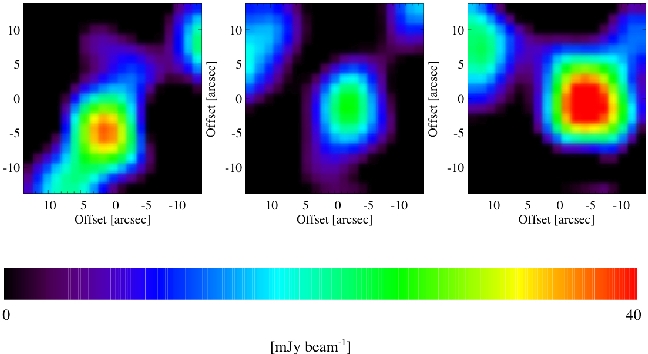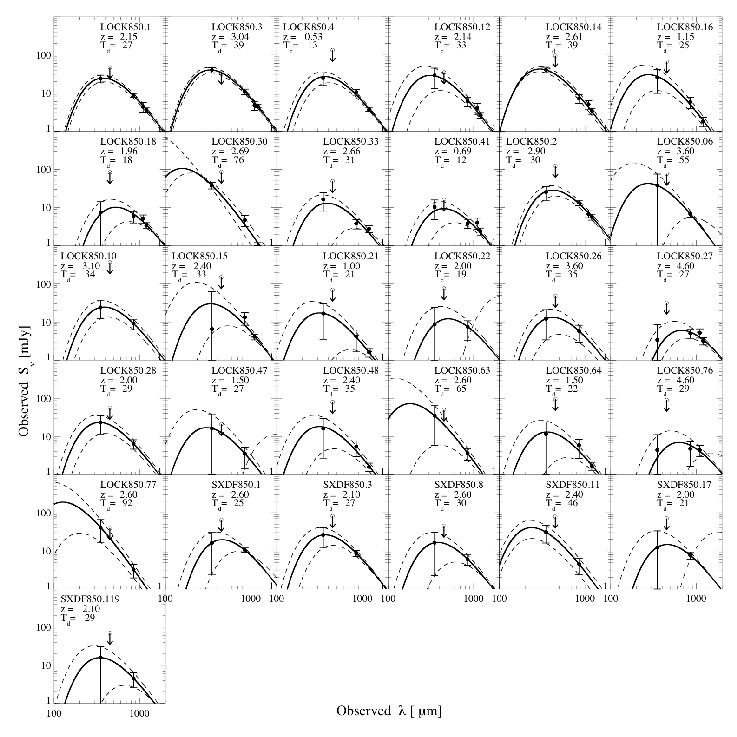
 SHARCII
Captures Images of Distant Dust-Enshrouded Galaxies
SHARCII
Captures Images of Distant Dust-Enshrouded Galaxies 
Galaxies formed many
billions of years ago in violent bursts of star-formation. A
by-product of these stellar factories is a large amount of dust, which
can often obscure optical light coming from the newly formed stars,
unfortunately making the stars sometimes extremely difficult to see
using optical telescopes. However, we can pinpoint these distant
dusty galaxies using submillimeter cameras which are sensitive to the
signatures of the cold dust emission. In this vein, a large
UK-led international consortium undertook the SCUBA HAlf Degree
Extragalactic Survey (SHADES), using the 850 micron SCUBA camera at the
James Clerk Maxwell Telescope in Hawaii, to map large contiguous
regions of sky in order to find these galaxies in the throes of
formation. But to elucidate the physics of these galaxies (such
as their dust content, power output, and temperatures), we need
additional measurements across a broad range of wavelengths in order to
construct their spectral energy distributions (SEDs). Critical
information comes from measuring the location and height of the SED
peak at shorter submillimeter wavelengths, such as with the 350 micron
channel of the CSO's SHARCII camera.
Dr. Kristen Coppin at Durham University in the UK and the SHADES
consortium took 350 micron SHARCII snapshots of several distant dusty
star-forming galaxies from SHADES. These new observations have
shown us these high-redshift 'submillimeter galaxies' contain about a
billion-suns -worth of cold dust (only ~30 degrees Kelvin above
absolute zero!) and that they are producing stars at hundreds of times
the rate of our own Milky Way galaxy. These distant submillimeter
galaxies are unlike nearby star-forming galaxies with similar
temperatures in that they are an order of magnitude more luminous and
dusty on average. This could mean that either the submillimeter
galaxies are much more massive compared with local starburst galaxies,
or possess a higher fraction of gas and dust than local galaxies, or
even that dust at high redshift could have different properties
altogether than local dust. Future surveys with BLAST, Herschel,
and SCUBA2 will be able to make the next leap in understanding the
physics in these extreme galaxies. This result was published by Coppin et al.
2008 in the Monthly Notices of the Royal Astronomical Society.

Figure 1. A zoomed in SHARCII snapshot of a few of brightest
submillimetre galaxies. These galaxies are very distant (it took o
ver 5-10 billion years for the light we see to reach us!) and are much
smaller in extent than the resolution of the CSO, which is wh
y they appear unresolved here as bright 'blobs'.

Figure 2. Dust emits thermal radiation in the far-infrared and so we
have fit simple thermal curves to the data points for each galaxy in
order to describe their energy output as a function of wavelength (the
solid lines are the 'best-fit' and the dotted lines indicate the error
bounds). The names on each plot indicate the region of sky that
the galaxies were found in (LOCK=Lockman Hole, SXDF=Subaru XMM Deep
Field), and the galaxy redshifts are also provided. You can see
how the new SHARCII data is crucial for constraining the location of
the peak of the model curves - which physically translates to measuring
the temperature of the dust that is emitting the radiation we are
seeing in Figure 1.

 SHARCII
Captures Images of Distant Dust-Enshrouded Galaxies
SHARCII
Captures Images of Distant Dust-Enshrouded Galaxies 

 SHARCII
Captures Images of Distant Dust-Enshrouded Galaxies
SHARCII
Captures Images of Distant Dust-Enshrouded Galaxies 

